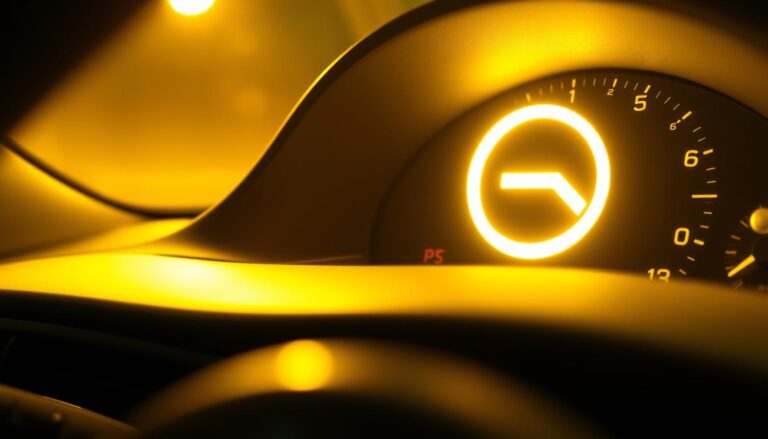Did you know that 95% of modern diesel vehicles have a diesel particulate filter (DPF)? This important part cuts down on harmful emissions. But, when the diesel particulate filter warning light comes on, it means you need to act fast. Knowing how to clear the DPF light is key to keeping your vehicle running well.
In this guide, I’ll make DPF troubleshooting easy for you. This way, you can handle this crucial part of your diesel engine with confidence.
Key Takeaways
- Understanding the role of the diesel particulate filter is crucial for vehicle maintenance.
- A lit DPF warning light indicates that immediate action is necessary.
- Incorporating regular DPF troubleshooting can prevent serious engine problems.
- Clearing the DPF light involves both simple and advanced steps.
- Knowing safe driving practices when the DPF light is on can protect your engine.
- Regular maintenance is essential to avoid DPF issues.
Understanding the Diesel Particulate Filter
The diesel particulate filter (DPF) is key in diesel vehicles’ exhaust systems. It catches soot and other harmful particles from combustion. This helps lower emissions and meets strict environmental rules, making the air cleaner.
The DPF works all the time the engine is on. It traps particles and then burns off the soot through regeneration. This burning is crucial for the DPF to keep working well, cleaning exhaust gases before they reach the air.
Keeping the DPF in good shape is important for the vehicle’s performance. A working DPF helps control emissions, saves fuel, and boosts the engine’s power. If ignored, it can cause problems that affect the whole vehicle.

What Does the DPF Light Mean?
When the diesel particulate filter (DPF) light comes on, it’s important to know what it means. This dpf warning indicator can show different problems with the DPF system. These issues can affect how well your car runs if not fixed right away.
The DPF light often means the filter is clogged. This blockage needs quick attention to avoid engine damage. Finding out why the DPF light is on is key. Sometimes, the system just needs a clean-up through regeneration to work right again.
Other times, the DPF light might mean there’s a bigger problem with the exhaust system. Knowing what the light means has helped me fix issues fast. This keeps my car running smoothly.

Common Causes of Diesel Particulate Filter Issues
Knowing the causes of dpf problems is key to fixing diesel particulate filter issues early. Short trips often don’t let the filter regenerate properly. This is because the engine doesn’t get hot enough to clean the filter. Also, too much idling, common in cities, builds up soot and can cause a dpf malfunction.
Using low-quality diesel fuel is another big problem. Such fuel makes more soot, worsening diesel particulate filter issues. This can block filters, hurt engine performance, and increase harmful emissions.
Here’s a summary of these causes:
| Cause | Description | Impact on DPF |
|---|---|---|
| Short Trips | Insufficient engine heat for filter regeneration | Soot accumulation |
| Excessive Idling | Running the engine at low speed for long periods | Soot build-up |
| Poor-quality Diesel Fuel | Fuel that does not meet required standards | Increased soot and potential blockages |

Recognizing the Diesel Particulate Filter Warning Light
Knowing what the DPF warning light looks like is key for diesel vehicle drivers. It shows up on the dashboard and warns of diesel particulate filter problems. It’s crucial to act fast when this light comes on to avoid bigger issues and expensive fixes. Here’s what you need to know about this light and what to do if you see it.
Characteristics of the DPF Warning Light
The DPF warning light usually shines in yellow or amber. This means the diesel particulate filter needs attention. Sometimes, the light flashes, which means it’s a bigger problem. Here are some important details:
- The light might show a simple filter outline or a warning message.
- Colors can vary—yellow warns you, while red means it’s critical.
- You might see extra warning symbols for specific DPF issues.
What to Do When You See the Light
When you see the DPF warning light, here’s what to do to keep your vehicle running well:
- Look for any odd performance issues, like power loss or strange sounds.
- Watch the temperature gauge; high heat could mean big problems.
- Try driving at higher RPMs for a bit to help the DPF regenerate, if it’s safe.
- If the light stays on, get a skilled mechanic to check it out.

Troubleshooting DPF Warning Signals
Seeing a DPF warning signal means you need to act fast. It’s key to find out why it’s happening. Start by looking at the engine management system. It can tell you a lot about possible problems.
Then, check the sensors linked to the DPF. Faulty sensors can cause false alarms. Fixing this can save you time and money.
Don’t forget to check the exhaust system. Look for leaks, as they can harm the DPF’s work. Regular checks keep the diesel particulate filter running well.

- Inspect engine management system for error codes.
- Test sensor inputs and outputs.
- Verify exhaust for leaks.
- Ensure proper fuel quality and additive usage.
- Look into previous maintenance history.
Keeping a record of these steps helps a lot. It makes solving DPF problems easier next time.
| Step | Action | Purpose |
|---|---|---|
| 1 | Check engine codes | Identify potential issues quickly |
| 2 | Test sensor functionality | Verify if sensors are operational |
| 3 | Inspect exhaust system | Ensure there’s no leakage |
| 4 | Review fuel quality | Maintain optimal combustion |
| 5 | Assess maintenance records | Check for repetitive issues |
What Happens When the DPF Light is Blinking?
A blinking dpf light means something serious is wrong. It’s a big worry, mainly for diesel car owners. The light could be due to sensor problems or engine issues. If ignored, it could cause serious damage.
A blinking light often means the diesel particulate filter is not working right. It might be too full of soot or have another problem. Sometimes, it could be a sensor issue that’s not sending the right signals.
Read Also : Clutch Pedal Vibrates Causes, Proplem
It’s very important to deal with the blinking light right away. Ignoring it could lead to bigger, more expensive problems. If you’re unsure, get a mechanic’s help or use a diagnostic tool to find out what’s wrong.
Knowing about the dpf light’s warning helps me take action early. This way, I can avoid bigger problems later.
| Indicator | Possible Causes | Recommended Action |
|---|---|---|
| DPF Light Blinking | Sensor Failure, Overfilled Filter, Exhaust Blockage | Immediate diagnosis and repair needed |
| DPF Light Solid | Normal Operation, Requires Maintenance | Schedule maintenance soon |
Step-by-Step Guide to Clearing the DPF Light
When the DPF light comes on, it’s time to take action. I’ve found that a step-by-step guide makes clearing the DPF light easier. Begin with some basic steps before using a diagnostic tool for dpf.
Initial Steps to Take
Before using complex tools, do some simple checks:
- Look for any leaks or damage around the exhaust system.
- Check the fuel quality and make sure the fuel filter is clean.
- Watch how you drive; short trips can stop the DPF from regenerating.
Using a Diagnostic Tool
For a deeper check, a diagnostic tool for dpf is key. Here’s how to use it:
- Plug the diagnostic tool into your vehicle’s OBD-II port.
- Turn the ignition on without starting the engine.
- Follow the tool’s instructions to find any error codes.
- Clear the codes to reset the DPF light.
- Keep an eye on any codes that don’t go away and fix the problems they show.
Safe Driving Practices When the DPF Light is On
Seeing the DPF light on my dashboard worries me. To stay safe, I change how I drive right away. I avoid sudden acceleration and braking to not put extra stress on the system.
Driving smoothly helps the exhaust flow properly. This is key when dealing with DPF problems.
Short trips can stop the diesel particulate filter from regenerating. So, I plan my trips to be longer. This lets the engine get to the right temperature for regeneration.
When the light comes on, I drive gently. This helps keep the exhaust clear.
Here are some tips for driving with DPF issues:
- Keep speeds moderate to help the system work better.
- Try to avoid short trips that don’t let the filter regenerate.
- Don’t drive aggressively, like speeding up and slowing down fast.
- Watch the vehicle’s temperature to make sure it’s running well.
Keeping my vehicle safe is always my top goal. By following these tips, I protect my car and the diesel particulate filter. A bit of caution can help keep my vehicle in good shape.
How to Clean the Diesel Particulate Filter
Cleaning the diesel particulate filter (DPF) is key to keeping your vehicle running well. There are many dpf cleaning methods that can make the filter last longer and save you money on replacements.
Professional cleaning is a top choice. It uses special tools to get the filter working like new. This is great for filters that are really dirty with soot and debris.
If you like to do things yourself, you can use dpf maintenance with special cleaning agents. These products break down the buildup, making sure the filter works right. But, always read and follow the instructions to avoid harming the filter.
For DIY fans, you can clean the filter at home with certain tools. Air compressors and pressure washers work well, but you need to be careful not to damage the filter’s parts.
Choosing any cleaning method regularly will keep your vehicle running smoothly and save on fuel. A consistent cleaning routine helps your vehicle last longer and perform better.
When to Replace Your Diesel Particulate Filter
It’s important to know when to replace your diesel particulate filter. This keeps your vehicle running well and meets emissions rules. Look out for signs of dpf failure like a DPF warning light, performance issues, or more exhaust smoke. Fixing these problems early can save you from costly repairs later.
Driving conditions and regular maintenance affect dpf longevity. Short trips can cause soot buildup because the DPF doesn’t get hot enough. If you’re always dealing with problems, it might be time for a new filter.
Keep an eye on your vehicle’s emissions and how it runs. Spotting signs of dpf failure early can help your filter last longer. Regular maintenance is key to keeping your dpf longevity high and avoiding early replacements.
Understanding DPF Regeneration
The dpf regeneration process is key for diesel engines to work well. It cleans the diesel particulate filter, which catches bad emissions. There are two main ways to do this: active and passive regeneration methods. Knowing about these can help my vehicle run better and keep emissions low.
Active vs. Passive Regeneration
Active regeneration starts when the engine control unit says it’s time. It needs high temperatures to burn off soot in the filter. The engine control unit changes how fuel is injected to heat up the exhaust, helping to burn off the soot.
Passive regeneration happens when I drive at higher speeds for a while. The exhaust gets hot enough to burn off soot on its own. This method works best when I drive on the highway a lot, as it keeps the filter clean.
Knowing when each method is used can make my diesel particulate filter last longer and work better. Regular maintenance and understanding my driving habits help with effective dpf regeneration.
| Regeneration Method | Conditions | Advantages | Disadvantages |
|---|---|---|---|
| Active Regeneration | Triggered by engine control unit | Efficient cleaning of filter | May reduce fuel efficiency |
| Passive Regeneration | Occurs during normal driving | No intervention needed | Dependent on driving habits |
The Importance of Regular Maintenance
Regular DPF maintenance is key for your diesel vehicle’s efficiency. It prevents buildup and clogs, avoiding expensive repairs. Ignoring this can harm your engine and the environment.
Regular checks and cleanings keep the DPF working well. This maintenance offers many benefits, including:
- Improved Fuel Efficiency: A clean filter means better exhaust flow, saving fuel.
- Extended Vehicle Life: A well-maintained DPF can make your vehicle last longer.
- Reduced Emissions: It also cuts down on harmful emissions, helping the environment.
Regular DPF care keeps your vehicle running smoothly and saves on repair costs. It’s a smart move for your diesel engine’s long-term health.
Diesel Particulate Filter Repair: DIY or Professional?
When dealing with diesel particulate filter problems, I often think about DIY versus professional help. Each option has its own benefits. Knowing these can help me decide what’s best for me.
Choosing diy dpf repair is tempting if I’m good with my hands and know a bit about tech. The good things are:
- It saves money on labor costs.
- I can fix it when I want to.
- It feels great to do it myself.
But, professional dpf service has its own pluses that are hard to overlook, like:
- They know how to solve tough problems.
- They have the right tools and equipment.
- They usually give a warranty, which makes me feel secure.
To show the differences, I made a table below. It highlights key points to think about when picking between these dpf repair options:
| Factor | DIY Repair | Professional Service |
|---|---|---|
| Cost | Lower upfront costs | Higher costs, but may save in long run |
| Expertise | Limited to personal skills | High level of experience in DPF repairs |
| Tools | May need to purchase or rent specialized tools | Tools are typically included in service |
| Time | Potentially longer, depending on skill level | Usually quicker turnaround due to experience |
In conclusion, whether I go for diy dpf repair or a professional dpf service depends on my situation. It’s important for me to look at my skills, budget, and what’s needed before making a choice.
Preventing Diesel Particulate Filter Issues
Keeping your vehicle in top shape starts with regular maintenance. Using high-quality diesel fuel is key for both engine health and dpf performance. I always choose premium fuel that meets industry standards. This helps reduce harmful emissions and boosts performance.
Short trips can harm the dpf. These trips don’t let the engine get hot enough for dpf regeneration. I make sure to take longer drives to burn off soot and keep the filter efficient.
Regular check-ups are a must for vehicle care. A skilled technician can spot dpf problems early. These maintenance tips for dpf help my vehicle run better and last longer.
Being proactive with maintenance is crucial. With the right fuel and dpf care, my vehicle stays reliable and has fewer problems.
Understanding DPF Warning Light: A Comprehensive Overview
The dpf warning light overview is key for diesel car owners. This light turns on when the diesel particulate filter has problems. It’s important to know what it means for your car’s health.
Seeing the DPF warning light means there are understanding dpf issues that need fixing fast. If you ignore it, your car could get damaged, cost more to fix, and use more fuel. So, it’s crucial to pay attention to it.
I always check a dpf troubleshooting guide when the light comes on. It shows how to find and fix the problem. The guide suggests steps like:
- Checking for exhaust leaks
- Evaluating the condition of the DPF
- Assessing the fuel injectors for any issues
- Examining the EGR system
Spotting the signs early helps fix problems before they get worse. Knowing about the dpf warning light overview helps me act quickly. This keeps my car running well.
| Warning Light | Possible Causes | Recommended Actions |
|---|---|---|
| Solid DPF Light | DPF blockage | Perform regeneration or clean DPF |
| Blinking DPF Light | Severe DPF issues | Seek professional diagnosis |
Being proactive about DPF issues saves money and keeps your car running longer. It makes driving more fun and safe.
Conclusion
When it comes to diesel particulate filter maintenance, keeping your DPF in top shape is key. We’ve looked at many aspects of the DPF, like common problems and how to fix them. It’s important to act fast when the DPF light comes on to save money and extend your vehicle’s life.
By following good DPF care habits, like regular checks and cleanings, you’ll see big improvements in your diesel engine’s performance. Don’t ignore warning signs, as they can lead to bigger problems. By following these tips, you’ll keep your DPF working well, enjoy a smoother ride, and use less fuel.
As we wrap up, remember to stay up-to-date with your vehicle’s needs and adjust your maintenance routine as needed. My last thoughts on DPF maintenance are simple: taking care of it now will pay off later. Happy driving!











